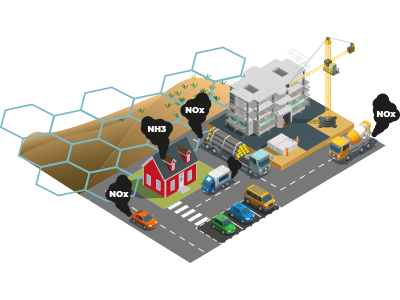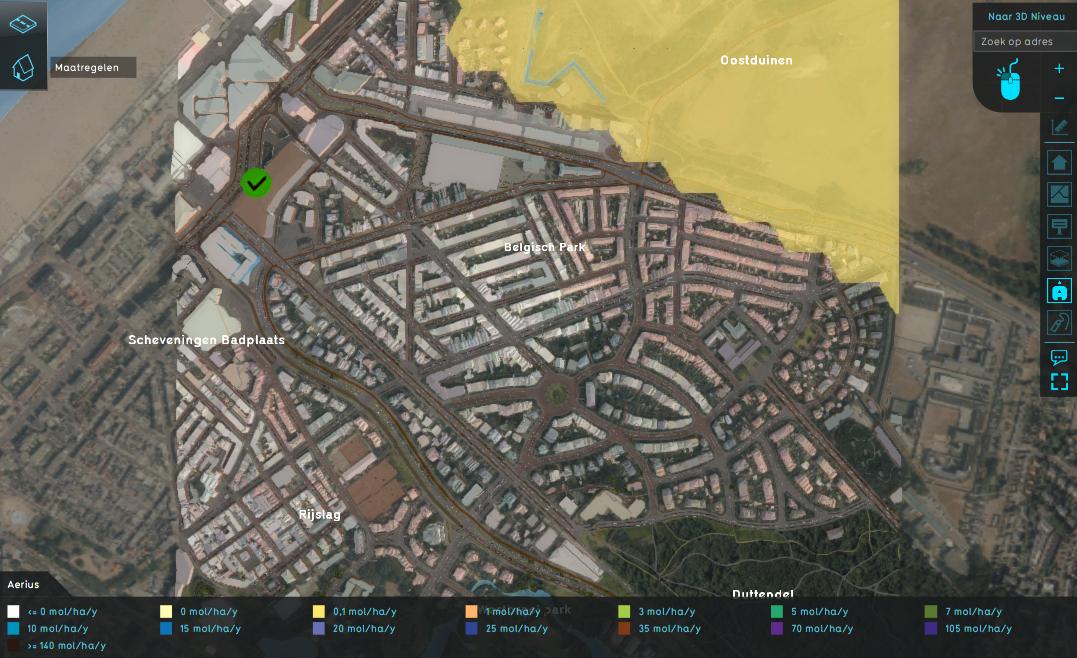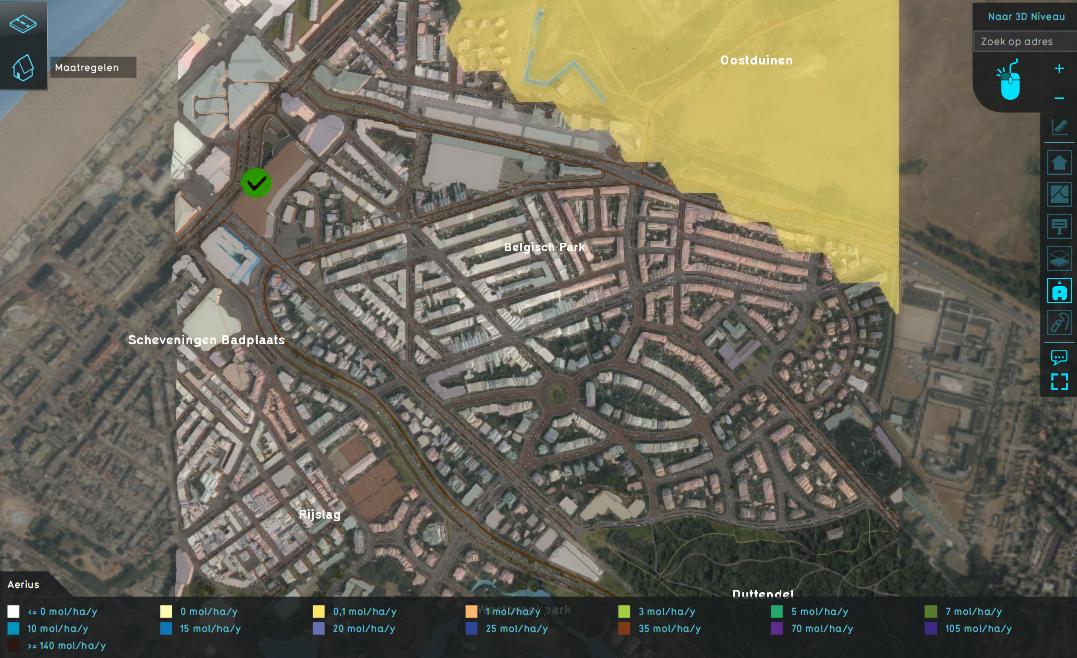Aerius Module overview: Difference between revisions
Jump to navigation
Jump to search
No edit summary |
No edit summary |
||
| Line 1: | Line 1: | ||
==Overview== | ==Overview== | ||
The RIVM [https://www.aerius.nl/nl Aerius] calculation tool | The RIVM [https://www.aerius.nl/nl Aerius] calculation tool calculates the impact of various emission sources on nitrogen deposition on Natura 2000 areas in the Netherlands. | ||
<br> | <br> | ||
The general concept is: <br> | |||
# Various sources, such as traffic and industry, emit NOx and NH3 into the air. The NOx and NH3 in the air eventually ends up on the ground, which is called nitrogen deposition. Nitrogen deposition is especially bad for the plants in nature reserves (Natura 2000 areas). For more information, see this [[RIVM page|https://www.rivm.nl/stikstof]] (in Dutch). | |||
# These sources of emissions are categorized by the Aerius Calculator into different (specific) sectors. | |||
# Aerius calculate for these different sectors the corresponding emissions and the amount of nitrogen deposition on Natura 2000 areas. | |||
[[File:aerius_introduction.png]] | [[File:aerius_introduction.png]] | ||
==Supported Sectors== | ==Supported Sectors== | ||
The Aerius Calculator tool can | The Aerius Calculator tool can calculate emissions for various sectors. | ||
Currently supported sectors in the {{software}} are: | Currently supported sectors in the {{software}} are: | ||
* Traffic (''Wegverkeer''): | * Traffic (''Wegverkeer''): | ||
** Sector 3113: local roads ('' | ** Sector 3113: local roads (''Binnen bebouwde kom'') | ||
** Sector 3112: rural roads ('' | ** Sector 3112: rural roads (''Buitenwegen'') | ||
** Sector 3111: highways ('' | ** Sector 3111: highways (''Snelwegen'') | ||
* Mobile machines (''Mobiele werktuigen''): | * Mobile machines (''Mobiele werktuigen''): | ||
** Sector 3220: Construction and industrial machines | ** Sector 3220: Construction and industrial machines (''Bouw en industrie'') | ||
* Plan (''Plan''): | * Plan (''Plan''): | ||
** Sector 9000: used construction materials and constructed type of buildings. | ** Sector 9000: used construction materials and constructed type of buildings. | ||
* Work and living ('' | * Work and living (''Wonen en werken''): | ||
** 8640: Work | ** 8640: Work (''Kantoren en winkels'') | ||
** 8200: Living | ** 8200: Living (''Woningen'') | ||
** 8210: Recreation | ** 8210: Recreation (''Recreatie'') | ||
==Input== | ==Input== | ||
* Traffic intensities for [[Light_traffic_num_(Aerius Overlay)|light]], [[Medium_traffic_num_(Aerius Overlay)|medium]] and [[Heavy_traffic_num_(Aerius Overlay)|heavy traffic]]. Optionally also [[Bus_traffic_num_(Aerius Overlay)|bus traffic]] | The input needed to make a calculation and visiualize the results in the [[Aerius overlay]], depends on the use case and the available data. Below an overview of the different datasets that can serve as input: | ||
* [[Traffic sector (Aerius Overlay)|Traffic sector]] the road belongs to. | * Traffic intensities for [[Light_traffic_num_(Aerius Overlay)|light]], [[Medium_traffic_num_(Aerius Overlay)|medium]] and [[Heavy_traffic_num_(Aerius Overlay)|heavy traffic]] per 24 hours. Optionally also [[Bus_traffic_num_(Aerius Overlay)|bus traffic]] and the [[Light_traffic_percentage_(Aerius Overlay)|congestion]] percentages. | ||
* [[Machinery_fuel_usage_(Aerius Overlay)|Fuel usage]] of construction machines, specified per [[Machinery_fuel_usage_(Aerius_Overlay)#Machine_categories|Machine category]]. | * The [[Traffic sector (Aerius Overlay)|Traffic sector]] the road belongs to (type of road, for example a highway). See the different types [[Aerius_module_overview#Supported_sectors]] | ||
* [[Plan_category_amounts_(Aerius Overlay)|Amounts per plan | * [[Machinery_fuel_usage_(Aerius Overlay)|Fuel usage]] in liter per year of construction machines, specified per [[Machinery_fuel_usage_(Aerius_Overlay)#Machine_categories|Machine category]]. | ||
* [[Plan_category_amounts_(Aerius Overlay)|Amounts per plan]], defined per function of building in the plan. | |||
* NOX and NH3 emissions for the [[Nox_work_(Aerius_Overlay)|work]], [[Nox_living_(Aerius Overlay)|living]] and [[Nox_living_(Aerius Overlay)|recreation]] sectors. | * NOX and NH3 emissions for the [[Nox_work_(Aerius_Overlay)|work]], [[Nox_living_(Aerius Overlay)|living]] and [[Nox_living_(Aerius Overlay)|recreation]] sectors. | ||
* [[Calculation year (Aerius Overlay)|Calculation year]], a value between 2014 and 2030. | * [[Calculation year (Aerius Overlay)|Calculation year]], a value between 2014 and 2030. | ||
Revision as of 13:10, 31 August 2020
Overview
The RIVM Aerius calculation tool calculates the impact of various emission sources on nitrogen deposition on Natura 2000 areas in the Netherlands.
The general concept is:
- Various sources, such as traffic and industry, emit NOx and NH3 into the air. The NOx and NH3 in the air eventually ends up on the ground, which is called nitrogen deposition. Nitrogen deposition is especially bad for the plants in nature reserves (Natura 2000 areas). For more information, see this https://www.rivm.nl/stikstof (in Dutch).
- These sources of emissions are categorized by the Aerius Calculator into different (specific) sectors.
- Aerius calculate for these different sectors the corresponding emissions and the amount of nitrogen deposition on Natura 2000 areas.
Supported Sectors
The Aerius Calculator tool can calculate emissions for various sectors. Currently supported sectors in the Tygron Platform are:
- Traffic (Wegverkeer):
- Sector 3113: local roads (Binnen bebouwde kom)
- Sector 3112: rural roads (Buitenwegen)
- Sector 3111: highways (Snelwegen)
- Mobile machines (Mobiele werktuigen):
- Sector 3220: Construction and industrial machines (Bouw en industrie)
- Plan (Plan):
- Sector 9000: used construction materials and constructed type of buildings.
- Work and living (Wonen en werken):
- 8640: Work (Kantoren en winkels)
- 8200: Living (Woningen)
- 8210: Recreation (Recreatie)
Input
The input needed to make a calculation and visiualize the results in the Aerius overlay, depends on the use case and the available data. Below an overview of the different datasets that can serve as input:
- Traffic intensities for light, medium and heavy traffic per 24 hours. Optionally also bus traffic and the congestion percentages.
- The Traffic sector the road belongs to (type of road, for example a highway). See the different types Aerius_module_overview#Supported_sectors
- Fuel usage in liter per year of construction machines, specified per Machine category.
- Amounts per plan, defined per function of building in the plan.
- NOX and NH3 emissions for the work, living and recreation sectors.
- Calculation year, a value between 2014 and 2030.
Output
- Emissions per building. These are summed up over all input type features for that building: traffic, machinery, amount per plan category and direct emissions. Often a single building has several plan category amounts, some direct emissions and construction machinery fuel usages.
- Grid cells containing the NOX or NH3 pollution based on overlapping Natura 2000 pollution hexagons.
- An array of hexagon values stored in the Aerius Overlay under the NOX and NH3 keys.
Result Types







